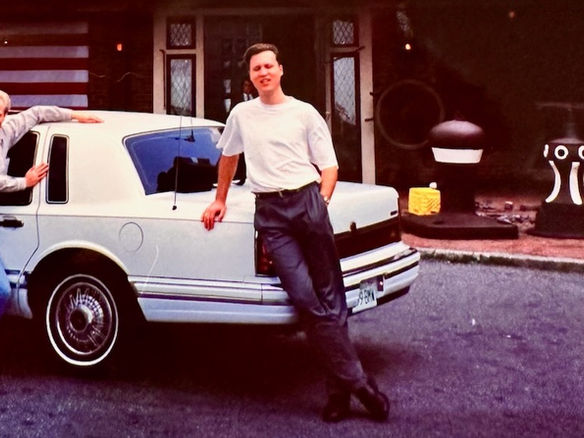Almost as soon as I could talk, I wanted to learn how to be a great storyteller.
I would waddle in a cloth nappy around my family’s humble fibro house telling lengthy and grandiose stories about my three great loves — my teddy bear, my trucks, and spaceships — until it was time for bed.
And not much has changed since then.
In service to the urge to tell a great story, I’ve often put my whole life on hold, to go on an adventure. Honestly, that’s the real reason why I’ve trekked in Ladakh, most of the reason I went to Antarctica, and the entire reason I captained the Australian team at the World Hide and Seek Championships in Italy. Sometimes, I just need a new story to tell.
So it actually makes a lot of sense that great storytelling has also been at the core of my professional career. This first began as a university student, then as a junior PR consultant, then as a tech journalist and tech magazine editor.
Where it all began…
It was while editing Australian Macworld magazine in the first few years of the 1990s that I fell in love with the third best storytelling industry in the world — tech (the first two places have to be awarded to the film and television industry, and the book publishing industry, obviously).

We actually put a computer on a ladder in front of an office building one evening to get this cover shot. Photoshop 2.0 was available but wasn’t yet capable of managing the resolution we’d have needed.
You see, kids these days won’t believe you, but the consumer internet we take for granted today didn’t exist in the early 1990s.
So while Australia and every other developed nation was replacing typewriters and clipboards with computers, networks and printers, the businesspeople making the tech purchasing decisions didn’t have the internet to guide them.
They needed to know what brand and model of computers to buy, what software to run, and the networking equipment needed to connect a printer and a fax machine.
And unless you were prepared to wait for the next annual computer trade show in your town, the information you needed to make your purchasing decisions could only be found in the pages of magazines like mine.
This put even young gun tech reporters like me in an unusually influential position, for which I was generously rewarded with business class travel, airport limousine pickups, five star hotels, and seven course dinners – I kid you not!
Barely into my twenties, yet directly influencing millions of dollars of tech purchasing decisions, I was flown to San Francisco so often I would sometimes barely touch down at home before packing my bags for my next trip (my shortest turnaround time record was 18 hours). I’d have to go (or more correctly, technology companies would have to send me) to write about a product launch or trade show, and interview the industry’s celebrity leaders, including Larry Ellison, Bill Gates, and even Steve Jobs.

A younger me, posing in front of the white stretch limo that had brought us to lunch with Apple execs at Boston’s finest seafood restaurant, during Macworld Expo Boston 1993.
From writing to doing
It was great work if you could get it, and I really got it. And I was happy, for a time, until I began to fall under the spell of some of the great tech storytellers; people like Steve Jobs, Jeff Hawkins of Palm, and Marc Canter of Macromedia.
Their stories inspired me to dream of a better future through technology. I longed to work on making these stories come true, rather than reporting on whether they were.
I could also see that the nascent web publishing industry would soon disrupt print publishing. But by then I had already left, initially to join Microsoft and work on some of the products that became part of MSN, and then to join Yahoo as an early employee.
The internet’s rapid growth in the late 1990s and its ability to not just acquire customers but monetise them (first with access charges and then, online advertising and ecommerce) fueled the crazily explosive growth of the Dotcom Boom.
How crazy? I have many stories about those times, such as how it felt to see the paper value of my employee stock options double, in the time between signing my employment contract and my first day in the office.
What fuelled that crazy explosion of excitement about tech startups? Some of it was maths: if the growth in these key metrics continues to accelerate exponentially… Some of it was the increasing power of technology devices: computing power roughly doubled every 18 months.
But mostly? It was skilful storytelling.
The unrivalled power of storytelling in tech
The startup industry is powered by our future stories.
Every new innovation, every software upgrade or hardware release, every pivot and every new market entry is accompanied by an inspiring tale of a better future — one where we’ll be more productive, more connected, and more fulfilled.
When told well, these stories are captivating, creative, and – above all else – convincing.
When I think about every one of the 30+ startups in my angel investment portfolio – the startups in the Blackbird 2012 fund I invested in, the founders I’ve coached in industry and university accelerators and incubators, and all the startups that I’d love to work with one day – it’s always about their stories.
But telling compelling stories about the future is hard work; much harder than stories about the present, or the past. Sometimes, we neglect our storytelling.
I often meet new founders who mistakenly believe that if they just present the facts as they stand, the historical data collected, and the unit economics of the business model, people will get onboard.
You and I know for certain that this is not true.
If facts and data were capable of inspiring belief, we wouldn’t live in a world with a runaway climate, QAnon conspiracies, and the real possibility of a second Trump presidency.
Public relations is an especially challenging form of storytelling because your goal isn’t as straightforward as inspiring the reader to believe, or to act. Your goal is to inspire the journalist in such a way as to get them to inspire their readers.
So last year, after seeing the great storytelling work being done by tech specialist PR agency Third Hemisphere for other clients, I commissioned them to be the storytelling experts for Fishburners, Australia’s oldest and biggest tech startup community, while I was acting as Interim CEO.
And at the end of my term as Interim CEO, when Third Hemisphere’s CEO Hannah Moreno asked me to join the team to help develop great stories for their tech startup clients, I leapt at the chance.
How this relates to tech founders
To be clear, a compelling startup story isn’t the only thing you need to succeed. Far from it.
There can be co founder disagreements, fraud, technical difficulties, privacy concerns, and many startups run out of money before they can turn their story into a reality.
Because that’s the thing about tech stories. They’re always about the future, and the future is never certain.
But even when things don’t go to plan, the stories we tell about the journey can be powerful and inspiring.
So if you’re a startup founder, please don’t make the mistake of under-investing in refining your story. Focus on the destination, not just on the journey so far.
And who knows, you might just inspire somebody to believe in you.










